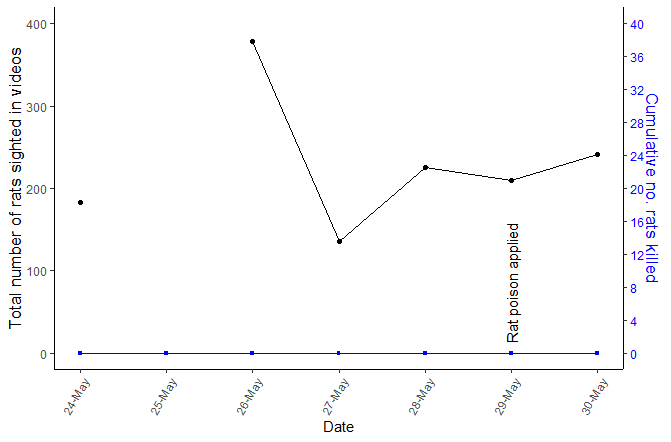For any task you need a clear objective – Kill all the rats. Check. There are 3 key elements required to successfully reach this objective – good plan, time, and money.
In the past, I have removed an occasional rat with my .22 and rat shot. I didn’t know at the time but this is when I first met One-Eyed Jack. Before that, his name was just Jack. More on that later. I knew this would not be a successful strategy – 1) because Jack (now One-eyed Jack) was still alive and 2) If you go out at dusk and shoot a couple of rats, their friends will wait until you are in bed before they come out again.
What’s a research statistics data nerd to do? Use the internet, of course! There is tons of information and misinformation. I found one source that was not only entertaining but also useful. The website by Shawn Woods called mousetrapmonday.com is THE testing grounds for all sorts of rat and mouse traps. You can spend hours on YouTube watching his videos (just ask my wife).
Rats are neophobic – meaning they are afraid of new things. It’s one of their keys to success. Once an invasive rodent is established, you must spend a lot of time gaining their trust before you begin to trap them.
So after some investigation here was Phase I of my plan:
- Pre-baiting – begin baiting with sunflower seeds to assess the enemy and the numbers of troops.
- Monitor – use a game camera set on video: 20 second clips with a 30-sec delay between triggers; count the minimum number of individual rats observed in each video clip; then sum the count for all videos after each night.
- Bait and switch – after letting the rats get comfortable with the sunflower seeds, switch out the seeds with a poison that is only toxic to rats.
- Analyze and adapt – track the count; assess the impact; and deploy Phase II.
A note about the poison. Rats (and gerbils, hamsters, and mice) cannot vomit. Unlike my dogs. It turns out that corn gluten and salt can kill rats and mice by stopping up their digestive system and causing dehydration. The rats become comatose and die in their burrows. Although poisonous to rats, corn gluten won’t hurt other wildlife – and other wildlife can eat any dead rats and not be poisoned themselves.
True to form, rats were reluctant to feed on the sunflower seeds. But they warmed up. The 5 days prior to replacing the seeds with poison, I was getting about 200 views of rats per night. On the 29th of May, I deployed the poison.

They took the bait…I mean…poison.
Unfortunately using this method precludes us from knowing how many succumbed. And while I could have monitored my video count to assess the effect, I was too excited about Phase II to wait that long.
I have no illusions of how this will end. Rat eradications have mostly been successful only on islands. Although Alberta, Canada has successfully eradicated the rat. But it took the Alberta government, with cooperation from the public, nearly a decade just to bring infestations under control! I only have one (hopefully) COVID summer.
-Duane Diefenbach
Posts in this series:
Diminishing Returns
Phase II: A repeating trap
Phase III: What every story needs
